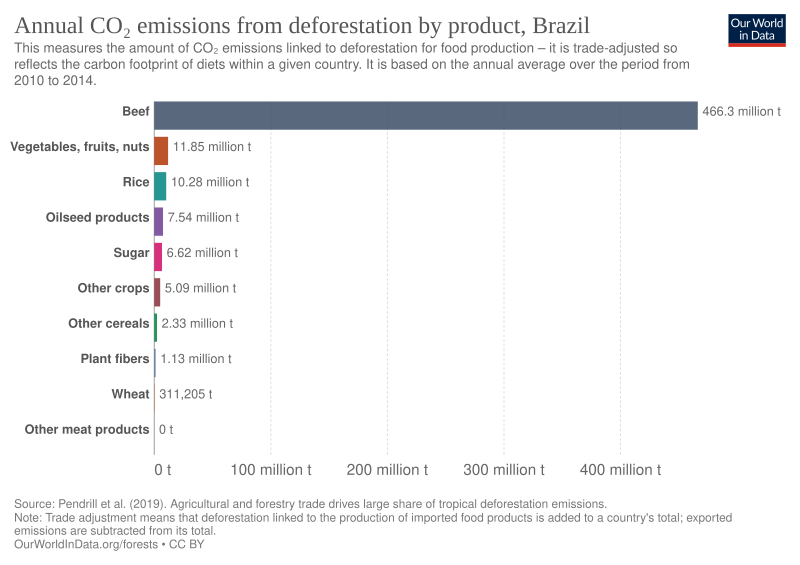File:Deforestation-co2-trade-by-product.svg

Original file (SVG file, nominally 850 × 600 pixels, file size: 28 KB)
Captions
Captions
Summary edit
| DescriptionDeforestation-co2-trade-by-product.svg |
English: Beef, soybeans and palm oil are the key drivers of deforestation
We know where deforestation emissions are occurring, and where this demand is coming from. But we also need to know what products are driving this. This helps consumers understand what products they should be concerned about, but also allows us to target specific supply chains. As we covered in a previous article, 60% of tropical deforestation is driven by beef, soybean and palm oil production. We should not only look at where these foods are produced, but also where the consumer demand is coming from. In the chart here we see the breakdown of deforestation emissions by product for each consumer country. The default is shown for Brazil, but you can explore the data for a range of countries using the “Change country” button. We see very clearly that the large Brazilian footprint is driven by its domestic demand for beef. In China, the biggest driver is demand for ‘oilseeds’ – which is the combination of soy imported from Latin America and palm oil, imported from Indonesia and Malaysia. Across the US and Europe the breakdown of products is more varied. But, overall, oilseeds and beef tend to top the list for most countries. Bringing all of these elements together, we can focus on a few points that should help us prioritise our efforts to end deforestation. Firstly, international trade does play a role in deforestation – it’s responsible for almost one-third of emissions. By combining our earlier Sankey diagram, and breakdown of emissions by product, we can see that we can tackle a large share of these emissions through only a few key trade flows. Most traded emissions are embedded in soy and palm oil exports to China and India; and beef, soy and palm oil exports to Europe. The story of both soy and palm oil are complex – and it’s not obvious that eliminating these products will fix the problem. We therefore look at them both individually in more detail, to better understand what we can do about it. But international markets alone cannot fix this problem. Most tropical deforestation is driven by demand for products in domestic markets. Brazil’s emissions are high because Brazilians eat a lot of beef. Africa’s emissions are high because people are clearing forests to produce more food. This means interventions at the national-level will be key: this can include a range of solutions including policies such as Brazil’s soy moratorium, the REDD+ programme to compensate for the opportunity costs of preserving these forests, and improvements in agricultural productivity so countries can continue to produce more food on less land. |
| Date | |
| Source | https://ourworldindata.org/deforestation |
| Author | Hannah Ritchie and Max Roser |
Licensing edit
- You are free:
- to share – to copy, distribute and transmit the work
- to remix – to adapt the work
- Under the following conditions:
- attribution – You must give appropriate credit, provide a link to the license, and indicate if changes were made. You may do so in any reasonable manner, but not in any way that suggests the licensor endorses you or your use.
- share alike – If you remix, transform, or build upon the material, you must distribute your contributions under the same or compatible license as the original.
File history
Click on a date/time to view the file as it appeared at that time.
| Date/Time | Thumbnail | Dimensions | User | Comment | |
|---|---|---|---|---|---|
| current | 15:47, 14 December 2021 |  | 850 × 600 (28 KB) | PJ Geest (talk | contribs) | Uploaded a work by Hannah Ritchie and Max Roser from https://ourworldindata.org/deforestation with UploadWizard |
You cannot overwrite this file.
File usage on Commons
There are no pages that use this file.
Metadata
This file contains additional information such as Exif metadata which may have been added by the digital camera, scanner, or software program used to create or digitize it. If the file has been modified from its original state, some details such as the timestamp may not fully reflect those of the original file. The timestamp is only as accurate as the clock in the camera, and it may be completely wrong.
| Width | 850 |
|---|---|
| Height | 600 |